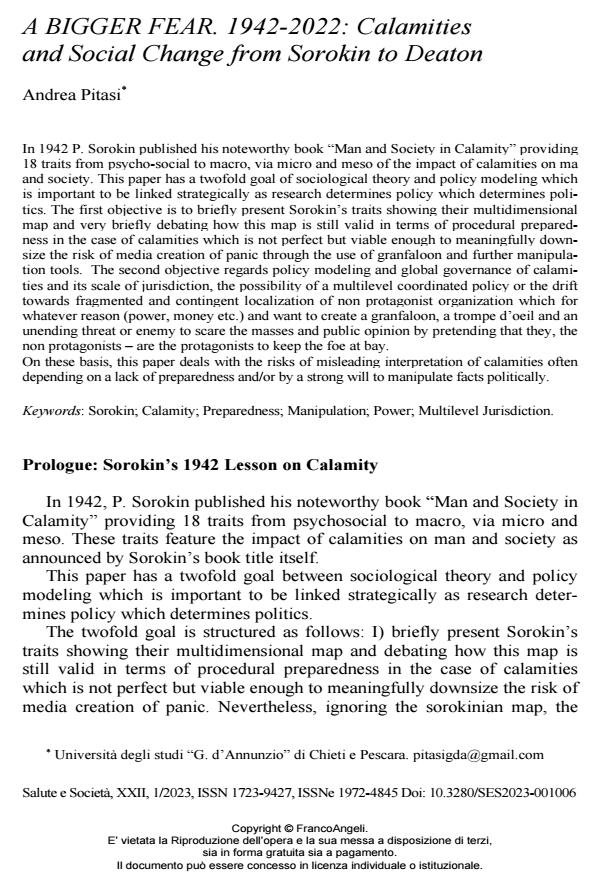A BIGGER FEAR. 1942-2022: Calamities and Social Change from Sorokin to Deaton
Titolo Rivista SALUTE E SOCIETÀ
Autori/Curatori Andrea Pitasi
Anno di pubblicazione 2023 Fascicolo 2023/1
Lingua Inglese Numero pagine 13 P. 72-84 Dimensione file 258 KB
DOI 10.3280/SES2023-001006
Il DOI è il codice a barre della proprietà intellettuale: per saperne di più
clicca qui
Qui sotto puoi vedere in anteprima la prima pagina di questo articolo.
Se questo articolo ti interessa, lo puoi acquistare (e scaricare in formato pdf) seguendo le facili indicazioni per acquistare il download credit. Acquista Download Credits per scaricare questo Articolo in formato PDF

FrancoAngeli è membro della Publishers International Linking Association, Inc (PILA)associazione indipendente e non profit per facilitare (attraverso i servizi tecnologici implementati da CrossRef.org) l’accesso degli studiosi ai contenuti digitali nelle pubblicazioni professionali e scientifiche
In 1942 P. Sorokin published his noteworthy book "Man and Society in Calamity" providing 18 traits from psycho-social to macro, via micro and meso of the impact of calamities on ma and society. This paper has a twofold goal of sociological theory and policy modeling which is important to be linked strategically as research determines policy which determines politics. The first objective is to briefly present Sorokin’s traits showing their multidimensional map and very briefly debating how this map is still valid in terms of procedural preparedness in the case of calamities which is not perfect but viable enough to meaningfully downsize the risk of media creation of panic through the use of granfaloon and further manipulation tools. The second objective regards policy modeling and global governance of calamities and its scale of jurisdiction, the possibility of a multilevel coordinated policy or the drift towards fragmented and contingent localization of non protagonist organization which for whatever reason (power, money etc.) and want to create a granfaloon, a trompe d’oeil and an unending threat or enemy to scare the masses and public opinion by pretending that they, the non protagonists - are the protagonists to keep the foe at bay. On these basis, this paper deals with the risks of misleading interpretation of calamities often depending on a lack of preparedness and/or by a strong will to manipulate facts politically.
Parole chiave:Sorokin; Calamity; Preparedness; Manipulation; Power; Multilevel Jurisdiction.
- Schürmann R. (1987). Heidegger on Being and Acting: From Principles to Anarchy. Bloomington: Indiana University Press.
- Cimagalli F. (2010). Sorokin. Attualità di un classico della sociologia. Rome: Aracne.
- Cipolla C. (2022). Un’epistemologia con noi, oltre noi, per gli altri: Pitirim A. Sorokin. Milan: FrancoAngeli.
- Cirla A. (2018). Umberto Eco – Sul complotto. Da Popper a Dan Brown (2015). -- Available at: https://www.youtube.com/watch?v=SltDcfpkLXk (25/01/2023).
- Cohen S. ( 2011) Folk Devils and Moral Panic, London- New York: Routledge.
- Deaton A. (2013). The Great Escape-Health, Wealth and the Origins of Inequality. Princeton: Princeton University Press.
- Esposito E. (2001). La memoria sociale. Roma-Bari: Laterza.
- Ferone E. (2010). Il sistema giudiziario nella fiction cine-televisiva tra approccio scientifico e bolla speculativa dei diritti. In: Pitasi A., ed., Regole e Finzioni. Il sistema giudiziario nella fiction cine-televisiva: Italia e USA a confronto. Milano: FrancoAngeli.
- Harris J. (2007). Enhancing Evolution. Princeton: Princeton University Press.
- Kaufmann S. (2000). Investigations. Oxford: OUP.
- Kuznets S. (1973). Population, Capital and Growth. New York: Norton.
- Lomborg B. (2021). False Alarm. New York: Basic Books.
- Luhmann N. (1989). Ecological Communication. Chicago: Chicago University Press.
- Malthus R.T. (2007). Un saggio sul principio della popolazione. New York: W.W. Norton & Co.
- Mangone E. (2018). Dalla calamità di Sorokin alla rinascita: la sociologia integrale per lo studio dei disastri. Milan: FrancoAngeli.
- Meadows D.H. (2018). Pensare per sistemi. Milano: GueriniNext.
- Meadows D.H., Meadows D.L, Randers J. (1992). Beyond The Limits. Vermont: Chelsea Green Publishing.
- Meadows D.H., Meadows D.L., Randers J., Behrens W.W. (1972). The Limits to Growth. New York: Photomac associates-Universe Books.
- Meadows D.H., Meadows D.L. (2003). The Limits of Growth 30 Years Later. Vermont: Chelsea Green Publishing.
- Pellizzoni L. (2020). The Time of Emergency. On the Governamental Logic of Preparedness. Sociologia Italiana, 16: 39-54. DOI: 10.1485/2281-2652-202016-
- Pitasi A. (2003). Universi paralleli. Milano: FrancoAngeli.
- Pitasi A. (2011). Le monde hyperhumain. Paris-Turin: L’Harmattan.
- Pitasi A., Mancini G. (2012). Systemic Shifts in Sociology. Saarbrücken: Lambert Academic Publishing.
- Praktanis A., Aronson E., (2001). Age of propaganda. New York: Henry Holt & Company.
- Rogers E.M. (1956). Diffusion of innovations. Glencoe: The Free Press of Glencoe.
- Sedano C. (2022). Dr. Andrea Pitasi, Hiperciudadanía, El juego del mundo, Universidad D’Annunzio, Italia. -- Available at: https://www.youtube.com/watch?v=vxEBC4EcQuM (25/01/2023).
- Smith L. (2011). The World in 2050. New York: Plume.
- Steiner C. (2012). Automate This. London: Penguin.
- Thaler R.H. (2018). Misbehaving. Torino: Einaudi.
Andrea Pitasi, A BIGGER FEAR. 1942-2022: Calamities and Social Change from Sorokin to Deaton in "SALUTE E SOCIETÀ" 1/2023, pp 72-84, DOI: 10.3280/SES2023-001006